How to Get Car Insurance Before Buying a Car in the USA
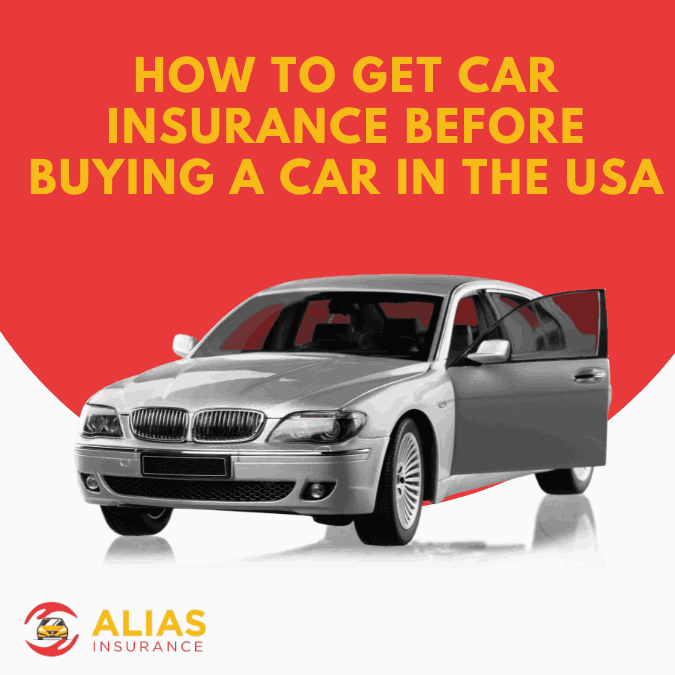
You can and should get car insurance before buying a car in the USA. In most states, proof of insurance is required before you can drive your new vehicle off the lot. Even if you have not finalized the purchase, many insurers let you set up a policy using the car’s details or estimated information. Having coverage in place ensures you meet legal requirements and stay protected from the moment you take ownership. Why You Must Have Car Insurance Before Buying a Car In the United States, most states require you to show proof of car insurance before registering or driving a vehicle. Dealers also want to protect their assets. That is why many dealerships will not allow you to take a car home without valid insurance. Even if you are paying with cash and buying from a private seller, you still need to be insured before you drive away. If you are in an accident on your way home and you do not have insurance, you could face big problems. These may include fines, license suspension, and legal costs. Here are some reasons why you must have car insurance before buying a vehicle: It is required by law in almost all states. It protects you from financial loss in case of an accident. It is needed to register your vehicle with the state DMV. Most dealers will not complete the sale without proof of insurance. Can You Get Insurance Without Owning a Car? Yes, you can. Insurance companies allow you to start a policy before you complete the purchase. This is known as a future effective policy. You can request that your insurance policy becomes active on the day you plan to buy the car. All you need is some basic information about the vehicle. In many cases, you do not need the exact Vehicle Identification Number, also called the VIN, to get a quote or even to begin the policy. If you know the make, model, and year of the car you want to buy, that is often enough to get started. Step-by-Step: How to Get Car Insurance Before Buying a Car Here is a simple step-by-step guide to help you get insurance before buying a car. Step 1: Choose the Car You Want You do not have to buy the car yet, but you need to know what type of car you are planning to purchase. The insurance company needs to know the: Make Model Year Trim level Estimated mileage If you have not finalized the car, you can still get a rough quote by providing a few options. Step 2: Collect Your Personal Information To get a quote, you must give the insurance company details about yourself. These include: Your name Your address Your date of birth Your driver’s license number Your driving history Your credit score (in some states) If you are financing or leasing the vehicle The insurance company uses this information to calculate your premium. Step 3: Compare Insurance Quotes Use a car insurance comparison site to get multiple quotes. This helps you see what different insurers are offering and what the prices are. Look for: Liability coverage Comprehensive coverage Collision coverage Uninsured motorist coverage Medical payments coverage Also ask about optional coverages like roadside assistance, rental reimbursement, and gap insurance. Comparison websites like Alias Insurance can help you compare free quotes from top companies in the USA. Step 4: Choose a Policy and Set Your Start Date After you review your quotes, pick a plan that suits your needs and budget. You can ask the insurer to make your policy active on the same day you plan to buy the car. This means your insurance will be valid the moment you drive away. Step 5: Update the Policy With the VIN Once you buy the car and have the VIN, you must contact the insurer and update your policy. The VIN is a 17-character number that gives full details of the vehicle. Your policy is not complete without it. Your insurer will then send you the official policy documents and your insurance ID card. Some even fax or email proof directly to the dealership. What If You Already Have Car Insurance? If you already own a car and have insurance, your current policy may automatically cover a new car for a short time. This is known as a grace period. It usually lasts from 7 to 30 days, depending on your insurer. The grace period lets you: Drive your new car home Update your policy later Keep coverage active without a lapse But grace periods only apply if: The new car replaces your old one You tell your insurer soon after purchase If this is your first car or you are not replacing a current vehicle, you must set up a new policy before you buy. Buying From a Dealer vs Buying From a Private Seller Getting insurance before buying a car is slightly different depending on where you are buying from. Buying from a Dealership Most dealers require proof of insurance before you can drive away. In fact, many will not allow the sale to go through without it. You can ask the dealership for the car’s VIN before completing the deal, then use that to get coverage. Dealers also offer help. Some may connect you with their partnered insurance companies right at the dealership. This is convenient but not always the cheapest. It is better to compare quotes yourself. Buying from a Private Seller When buying from a private party, you will need to gather all the car details yourself. Ask the seller for the: VIN Odometer reading Maintenance records Current registration Once you know which car you are buying, get a quote and set up the policy for the day you plan to take ownership. What Kind of Coverage Do You Need? Here is a quick overview of different types of car insurance coverage: Type of Coverage What It Covers Liability Injuries and damage to others if
Does No-Fault Insurance Cover Car Damage?
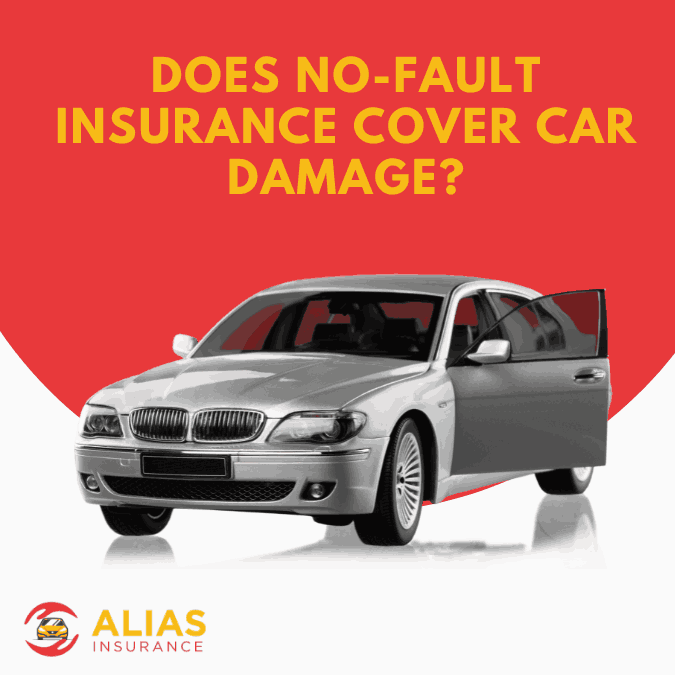
Car insurance is a legal requirement in almost every U.S. state, but for many people, the upfront cost can be a major financial barrier. If you are wondering whether you can get car insurance with no down payment, the short answer is — it depends. While most insurers require some form of payment to start a policy, there are ways to reduce or eliminate that initial cost. In this detailed guide, we will explain how no down payment car insurance works, who qualifies, what to watch out for, and how to get the most affordable policy in 2025 without paying hundreds upfront. What Is No Down Payment Car Insurance? No down payment car insurance means getting a policy started without making a large upfront payment. In traditional policies, the first month’s premium or a deposit is required before coverage begins. With no down payment insurance, you might only be required to pay your first month’s premium — or even just a small processing fee. However, it is important to understand that there is no such thing as truly free car insurance. You are still required to pay for coverage, but these options allow you to: Spread payments over time Avoid large upfront costs Get insured with limited cash on hand How Does It Work? When you purchase a traditional car insurance policy, most companies ask for: First month’s premium Or a percentage of the full premium as a deposit With a no down payment plan, insurers allow you to start coverage with just the first month’s premium — and in rare cases, even defer it for a short period. These plans are usually available through: Monthly installment options State-backed or non-standard providers Insurance comparison platforms like Alias Insurance Who Offers No Down Payment Car Insurance? Not all insurers provide this option, but some companies offer low or no upfront payment plans based on your profile and state regulations. These include: Progressive GEICO State Farm Dairyland The General Acceptance Insurance You can use quote comparison platforms like Alias Insurance to compare these providers and find those offering flexible payments. Who Qualifies for No Down Payment Car Insurance Eligibility varies depending on the provider and your personal details. Generally, you are more likely to qualify if you: Have a clean driving record Have good credit or payment history Are over 25 years old Live in a state that allows installment-based policies Choose basic liability coverage If you are a high-risk driver, have a poor credit score, or require full coverage, you may still qualify but expect to pay slightly more monthly. States Where No Down Payment Insurance Is More Common Not all states allow deferred payments or zero-down car insurance, but it is more accessible in: California Florida Texas Arizona Georgia South Carolina Nevada Always check with your local Department of Insurance or an agent to confirm availability. Pros and Cons of No Down Payment Car Insurance ✅ Advantages No large upfront cost Coverage starts immediately Ideal for low-income drivers or students Easier budgeting with monthly payments ❌ Disadvantages Higher monthly premiums Not available in every state May require automatic payments Limited options for high-risk drivers How Much Does It Cost? Here’s a comparison between traditional and no down payment insurance: Policy Type Upfront Cost Monthly Payment Total Cost (6 Months) Traditional Policy $250 – $500 $90 – $130 $790 – $1,280 No Down Payment Policy $0 – $50 $100 – $150 $600 – $900 You may end up paying slightly more monthly, but save big initially. Tips to Qualify and Save To improve your chances of getting no down payment car insurance, try these tips: Maintain a clean driving record Improve your credit score Choose liability-only coverage Bundle with renters or home insurance Ask about usage-based discounts Use quote comparison sites to shop around Alternatives to No Down Payment Insurance If you cannot find a true no-down-payment policy, consider these options: $20 Down Car Insurance: Many insurers offer policies with only $20 required upfront. Pay-As-You-Go Car Insurance: Pay based on how much you drive, perfect for low-mileage drivers. State-Sponsored Plans: Some states offer low-income auto insurance programs with reduced upfront costs. Is It Legit or a Scam? Legitimate insurers may advertise “no down payment car insurance,” but be cautious of: Unlicensed companies Hidden processing fees Too-good-to-be-true offers Always verify the insurer’s license with your state’s Department of Insurance. FAQs: People Also Ask Can I get no down payment insurance with bad credit? Yes, but you may pay higher monthly rates. Shopping around is key. Is it legal in every state? No. Some states require a full first month’s premium before a policy becomes active Do I still need to provide proof of insurance? Yes. Regardless of how you pay, you must carry proof of insurance at all times. Can I cancel anytime? Yes, but cancellation fees may apply. Read your contract carefully. Does it include full coverage? Yes, if you choose it. No down payment plans can be liability-only or full coverage depending on what you buy. Conclusion: Is No Down Payment Insurance Right for You? If you are short on cash but need to drive legally, no down payment car insurance can be a great solution. It provides the same protection as traditional policies without the financial burden upfront. Just remember: It is not completely free — you still pay for coverage Compare quotes to get the best monthly rates Review terms carefully to avoid unexpected fees At Alias Insurance, we help you compare top-rated insurers that offer flexible payment plans, including no or low down payment options. Find the right coverage for your situation today and drive with confidence. External Resource Links National Association of Insurance Commissioners (NAIC) Insurance Information Institute – How Car Insurance Works California Department of Insurance – Low-Cost Auto Insurance AliasInsurance.com – Compare Free Quotes
What Does a No-Fault State Mean for Car Insurance?
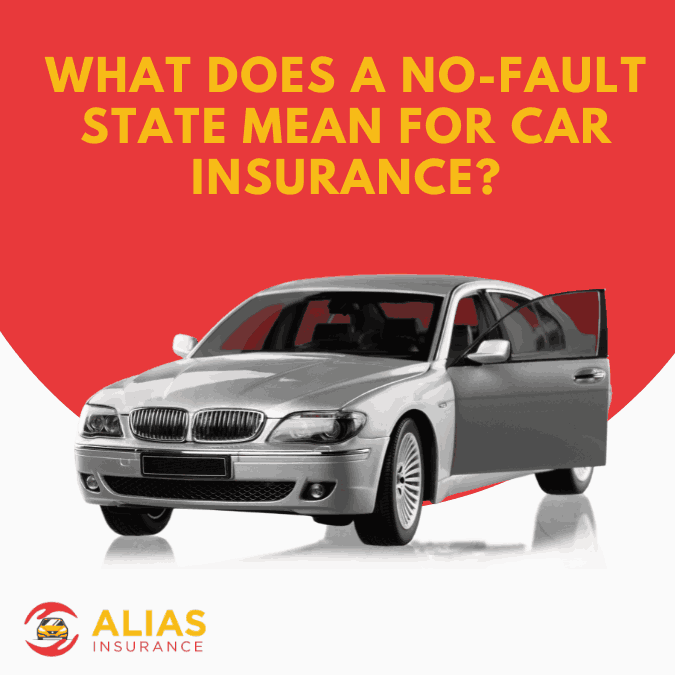
Car insurance is a legal requirement in almost every U.S. state, but for many people, the upfront cost can be a major financial barrier. If you are wondering whether you can get car insurance with no down payment, the short answer is — it depends. While most insurers require some form of payment to start a policy, there are ways to reduce or eliminate that initial cost. In this detailed guide, we will explain how no down payment car insurance works, who qualifies, what to watch out for, and how to get the most affordable policy in 2025 without paying hundreds upfront. What Is No Down Payment Car Insurance? No down payment car insurance means getting a policy started without making a large upfront payment. In traditional policies, the first month’s premium or a deposit is required before coverage begins. With no down payment insurance, you might only be required to pay your first month’s premium — or even just a small processing fee. However, it is important to understand that there is no such thing as truly free car insurance. You are still required to pay for coverage, but these options allow you to: Spread payments over time Avoid large upfront costs Get insured with limited cash on hand How Does It Work? When you purchase a traditional car insurance policy, most companies ask for: First month’s premium Or a percentage of the full premium as a deposit With a no down payment plan, insurers allow you to start coverage with just the first month’s premium — and in rare cases, even defer it for a short period. These plans are usually available through: Monthly installment options State-backed or non-standard providers Insurance comparison platforms like Alias Insurance Who Offers No Down Payment Car Insurance? Not all insurers provide this option, but some companies offer low or no upfront payment plans based on your profile and state regulations. These include: Progressive GEICO State Farm Dairyland The General Acceptance Insurance You can use quote comparison platforms like Alias Insurance to compare these providers and find those offering flexible payments. Who Qualifies for No Down Payment Car Insurance Eligibility varies depending on the provider and your personal details. Generally, you are more likely to qualify if you: Have a clean driving record Have good credit or payment history Are over 25 years old Live in a state that allows installment-based policies Choose basic liability coverage If you are a high-risk driver, have a poor credit score, or require full coverage, you may still qualify but expect to pay slightly more monthly. States Where No Down Payment Insurance Is More Common Not all states allow deferred payments or zero-down car insurance, but it is more accessible in: California Florida Texas Arizona Georgia South Carolina Nevada Always check with your local Department of Insurance or an agent to confirm availability. Pros and Cons of No Down Payment Car Insurance ✅ Advantages No large upfront cost Coverage starts immediately Ideal for low-income drivers or students Easier budgeting with monthly payments ❌ Disadvantages Higher monthly premiums Not available in every state May require automatic payments Limited options for high-risk drivers How Much Does It Cost? Here’s a comparison between traditional and no down payment insurance: Policy Type Upfront Cost Monthly Payment Total Cost (6 Months) Traditional Policy $250 – $500 $90 – $130 $790 – $1,280 No Down Payment Policy $0 – $50 $100 – $150 $600 – $900 You may end up paying slightly more monthly, but save big initially. Tips to Qualify and Save To improve your chances of getting no down payment car insurance, try these tips: Maintain a clean driving record Improve your credit score Choose liability-only coverage Bundle with renters or home insurance Ask about usage-based discounts Use quote comparison sites to shop around Alternatives to No Down Payment Insurance If you cannot find a true no-down-payment policy, consider these options: $20 Down Car Insurance: Many insurers offer policies with only $20 required upfront. Pay-As-You-Go Car Insurance: Pay based on how much you drive, perfect for low-mileage drivers. State-Sponsored Plans: Some states offer low-income auto insurance programs with reduced upfront costs. Is It Legit or a Scam? Legitimate insurers may advertise “no down payment car insurance,” but be cautious of: Unlicensed companies Hidden processing fees Too-good-to-be-true offers Always verify the insurer’s license with your state’s Department of Insurance. FAQs: People Also Ask Can I get no down payment insurance with bad credit? Yes, but you may pay higher monthly rates. Shopping around is key. Is it legal in every state? No. Some states require a full first month’s premium before a policy becomes active Do I still need to provide proof of insurance? Yes. Regardless of how you pay, you must carry proof of insurance at all times. Can I cancel anytime? Yes, but cancellation fees may apply. Read your contract carefully. Does it include full coverage? Yes, if you choose it. No down payment plans can be liability-only or full coverage depending on what you buy. Conclusion: Is No Down Payment Insurance Right for You? If you are short on cash but need to drive legally, no down payment car insurance can be a great solution. It provides the same protection as traditional policies without the financial burden upfront. Just remember: It is not completely free — you still pay for coverage Compare quotes to get the best monthly rates Review terms carefully to avoid unexpected fees At Alias Insurance, we help you compare top-rated insurers that offer flexible payment plans, including no or low down payment options. Find the right coverage for your situation today and drive with confidence. External Resource Links National Association of Insurance Commissioners (NAIC) Insurance Information Institute – How Car Insurance Works California Department of Insurance – Low-Cost Auto Insurance AliasInsurance.com – Compare Free Quotes
Is Florida a No-Fault Car Insurance State?
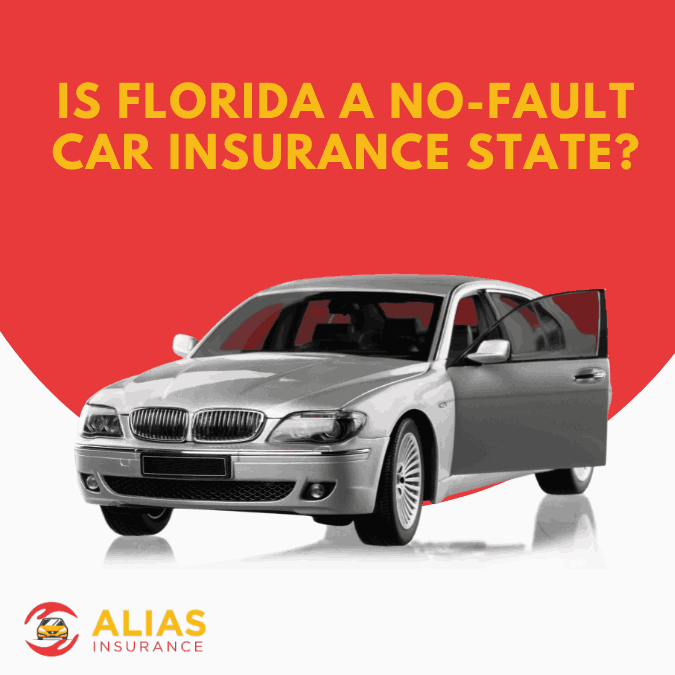
Car insurance is a legal requirement in almost every U.S. state, but for many people, the upfront cost can be a major financial barrier. If you are wondering whether you can get car insurance with no down payment, the short answer is — it depends. While most insurers require some form of payment to start a policy, there are ways to reduce or eliminate that initial cost. In this detailed guide, we will explain how no down payment car insurance works, who qualifies, what to watch out for, and how to get the most affordable policy in 2025 without paying hundreds upfront. What Is No Down Payment Car Insurance? No down payment car insurance means getting a policy started without making a large upfront payment. In traditional policies, the first month’s premium or a deposit is required before coverage begins. With no down payment insurance, you might only be required to pay your first month’s premium — or even just a small processing fee. However, it is important to understand that there is no such thing as truly free car insurance. You are still required to pay for coverage, but these options allow you to: Spread payments over time Avoid large upfront costs Get insured with limited cash on hand How Does It Work? When you purchase a traditional car insurance policy, most companies ask for: First month’s premium Or a percentage of the full premium as a deposit With a no down payment plan, insurers allow you to start coverage with just the first month’s premium — and in rare cases, even defer it for a short period. These plans are usually available through: Monthly installment options State-backed or non-standard providers Insurance comparison platforms like Alias Insurance Who Offers No Down Payment Car Insurance? Not all insurers provide this option, but some companies offer low or no upfront payment plans based on your profile and state regulations. These include: Progressive GEICO State Farm Dairyland The General Acceptance Insurance You can use quote comparison platforms like Alias Insurance to compare these providers and find those offering flexible payments. Who Qualifies for No Down Payment Car Insurance Eligibility varies depending on the provider and your personal details. Generally, you are more likely to qualify if you: Have a clean driving record Have good credit or payment history Are over 25 years old Live in a state that allows installment-based policies Choose basic liability coverage If you are a high-risk driver, have a poor credit score, or require full coverage, you may still qualify but expect to pay slightly more monthly. States Where No Down Payment Insurance Is More Common Not all states allow deferred payments or zero-down car insurance, but it is more accessible in: California Florida Texas Arizona Georgia South Carolina Nevada Always check with your local Department of Insurance or an agent to confirm availability. Pros and Cons of No Down Payment Car Insurance ✅ Advantages No large upfront cost Coverage starts immediately Ideal for low-income drivers or students Easier budgeting with monthly payments ❌ Disadvantages Higher monthly premiums Not available in every state May require automatic payments Limited options for high-risk drivers How Much Does It Cost? Here’s a comparison between traditional and no down payment insurance: Policy Type Upfront Cost Monthly Payment Total Cost (6 Months) Traditional Policy $250 – $500 $90 – $130 $790 – $1,280 No Down Payment Policy $0 – $50 $100 – $150 $600 – $900 You may end up paying slightly more monthly, but save big initially. Tips to Qualify and Save To improve your chances of getting no down payment car insurance, try these tips: Maintain a clean driving record Improve your credit score Choose liability-only coverage Bundle with renters or home insurance Ask about usage-based discounts Use quote comparison sites to shop around Alternatives to No Down Payment Insurance If you cannot find a true no-down-payment policy, consider these options: $20 Down Car Insurance: Many insurers offer policies with only $20 required upfront. Pay-As-You-Go Car Insurance: Pay based on how much you drive, perfect for low-mileage drivers. State-Sponsored Plans: Some states offer low-income auto insurance programs with reduced upfront costs. Is It Legit or a Scam? Legitimate insurers may advertise “no down payment car insurance,” but be cautious of: Unlicensed companies Hidden processing fees Too-good-to-be-true offers Always verify the insurer’s license with your state’s Department of Insurance. FAQs: People Also Ask Can I get no down payment insurance with bad credit? Yes, but you may pay higher monthly rates. Shopping around is key. Is it legal in every state? No. Some states require a full first month’s premium before a policy becomes active Do I still need to provide proof of insurance? Yes. Regardless of how you pay, you must carry proof of insurance at all times. Can I cancel anytime? Yes, but cancellation fees may apply. Read your contract carefully. Does it include full coverage? Yes, if you choose it. No down payment plans can be liability-only or full coverage depending on what you buy. Conclusion: Is No Down Payment Insurance Right for You? If you are short on cash but need to drive legally, no down payment car insurance can be a great solution. It provides the same protection as traditional policies without the financial burden upfront. Just remember: It is not completely free — you still pay for coverage Compare quotes to get the best monthly rates Review terms carefully to avoid unexpected fees At Alias Insurance, we help you compare top-rated insurers that offer flexible payment plans, including no or low down payment options. Find the right coverage for your situation today and drive with confidence. External Resource Links National Association of Insurance Commissioners (NAIC) Insurance Information Institute – How Car Insurance Works California Department of Insurance – Low-Cost Auto Insurance AliasInsurance.com – Compare Free Quotes
Where Can I Get Car Insurance with No Down Payment?
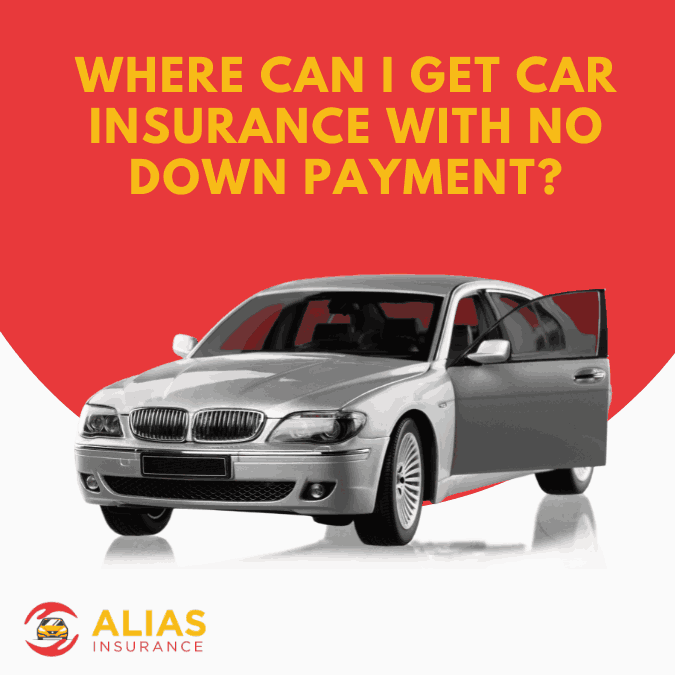
Car insurance is a legal requirement in almost every U.S. state, but for many people, the upfront cost can be a major financial barrier. If you are wondering whether you can get car insurance with no down payment, the short answer is — it depends. While most insurers require some form of payment to start a policy, there are ways to reduce or eliminate that initial cost. In this detailed guide, we will explain how no down payment car insurance works, who qualifies, what to watch out for, and how to get the most affordable policy in 2025 without paying hundreds upfront. What Is No Down Payment Car Insurance? No down payment car insurance means getting a policy started without making a large upfront payment. In traditional policies, the first month’s premium or a deposit is required before coverage begins. With no down payment insurance, you might only be required to pay your first month’s premium — or even just a small processing fee. However, it is important to understand that there is no such thing as truly free car insurance. You are still required to pay for coverage, but these options allow you to: Spread payments over time Avoid large upfront costs Get insured with limited cash on hand How Does It Work? When you purchase a traditional car insurance policy, most companies ask for: First month’s premium Or a percentage of the full premium as a deposit With a no down payment plan, insurers allow you to start coverage with just the first month’s premium — and in rare cases, even defer it for a short period. These plans are usually available through: Monthly installment options State-backed or non-standard providers Insurance comparison platforms like Alias Insurance Who Offers No Down Payment Car Insurance? Not all insurers provide this option, but some companies offer low or no upfront payment plans based on your profile and state regulations. These include: Progressive GEICO State Farm Dairyland The General Acceptance Insurance You can use quote comparison platforms like Alias Insurance to compare these providers and find those offering flexible payments. Who Qualifies for No Down Payment Car Insurance Eligibility varies depending on the provider and your personal details. Generally, you are more likely to qualify if you: Have a clean driving record Have good credit or payment history Are over 25 years old Live in a state that allows installment-based policies Choose basic liability coverage If you are a high-risk driver, have a poor credit score, or require full coverage, you may still qualify but expect to pay slightly more monthly. States Where No Down Payment Insurance Is More Common Not all states allow deferred payments or zero-down car insurance, but it is more accessible in: California Florida Texas Arizona Georgia South Carolina Nevada Always check with your local Department of Insurance or an agent to confirm availability. Pros and Cons of No Down Payment Car Insurance ✅ Advantages No large upfront cost Coverage starts immediately Ideal for low-income drivers or students Easier budgeting with monthly payments ❌ Disadvantages Higher monthly premiums Not available in every state May require automatic payments Limited options for high-risk drivers How Much Does It Cost? Here’s a comparison between traditional and no down payment insurance: Policy Type Upfront Cost Monthly Payment Total Cost (6 Months) Traditional Policy $250 – $500 $90 – $130 $790 – $1,280 No Down Payment Policy $0 – $50 $100 – $150 $600 – $900 You may end up paying slightly more monthly, but save big initially. Tips to Qualify and Save To improve your chances of getting no down payment car insurance, try these tips: Maintain a clean driving record Improve your credit score Choose liability-only coverage Bundle with renters or home insurance Ask about usage-based discounts Use quote comparison sites to shop around Alternatives to No Down Payment Insurance If you cannot find a true no-down-payment policy, consider these options: $20 Down Car Insurance: Many insurers offer policies with only $20 required upfront. Pay-As-You-Go Car Insurance: Pay based on how much you drive, perfect for low-mileage drivers. State-Sponsored Plans: Some states offer low-income auto insurance programs with reduced upfront costs. Is It Legit or a Scam? Legitimate insurers may advertise “no down payment car insurance,” but be cautious of: Unlicensed companies Hidden processing fees Too-good-to-be-true offers Always verify the insurer’s license with your state’s Department of Insurance. FAQs: People Also Ask Can I get no down payment insurance with bad credit? Yes, but you may pay higher monthly rates. Shopping around is key. Is it legal in every state? No. Some states require a full first month’s premium before a policy becomes active Do I still need to provide proof of insurance? Yes. Regardless of how you pay, you must carry proof of insurance at all times. Can I cancel anytime? Yes, but cancellation fees may apply. Read your contract carefully. Does it include full coverage? Yes, if you choose it. No down payment plans can be liability-only or full coverage depending on what you buy. Conclusion: Is No Down Payment Insurance Right for You? If you are short on cash but need to drive legally, no down payment car insurance can be a great solution. It provides the same protection as traditional policies without the financial burden upfront. Just remember: It is not completely free — you still pay for coverage Compare quotes to get the best monthly rates Review terms carefully to avoid unexpected fees At Alias Insurance, we help you compare top-rated insurers that offer flexible payment plans, including no or low down payment options. Find the right coverage for your situation today and drive with confidence. External Resource Links National Association of Insurance Commissioners (NAIC) Insurance Information Institute – How Car Insurance Works California Department of Insurance – Low-Cost Auto Insurance AliasInsurance.com – Compare Free Quotes
How to Get Car Insurance with No Down Payment in the USA
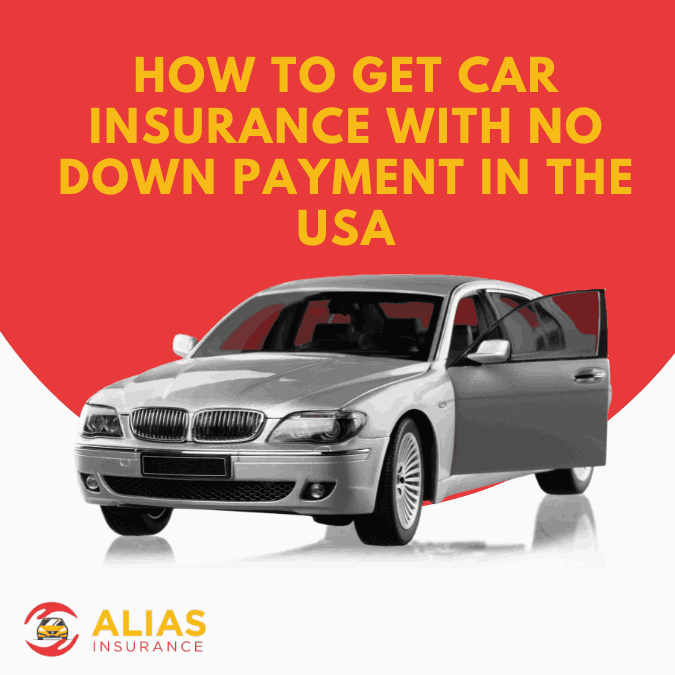
Car insurance is a legal requirement in almost every U.S. state, but for many people, the upfront cost can be a major financial barrier. If you are wondering whether you can get car insurance with no down payment, the short answer is — it depends. While most insurers require some form of payment to start a policy, there are ways to reduce or eliminate that initial cost. In this detailed guide, we will explain how no down payment car insurance works, who qualifies, what to watch out for, and how to get the most affordable policy in 2025 without paying hundreds upfront. What Is No Down Payment Car Insurance? No down payment car insurance means getting a policy started without making a large upfront payment. In traditional policies, the first month’s premium or a deposit is required before coverage begins. With no down payment insurance, you might only be required to pay your first month’s premium — or even just a small processing fee. However, it is important to understand that there is no such thing as truly free car insurance. You are still required to pay for coverage, but these options allow you to: Spread payments over time Avoid large upfront costs Get insured with limited cash on hand How Does It Work? When you purchase a traditional car insurance policy, most companies ask for: First month’s premium Or a percentage of the full premium as a deposit With a no down payment plan, insurers allow you to start coverage with just the first month’s premium — and in rare cases, even defer it for a short period. These plans are usually available through: Monthly installment options State-backed or non-standard providers Insurance comparison platforms like Alias Insurance Who Offers No Down Payment Car Insurance? Not all insurers provide this option, but some companies offer low or no upfront payment plans based on your profile and state regulations. These include: Progressive GEICO State Farm Dairyland The General Acceptance Insurance You can use quote comparison platforms like Alias Insurance to compare these providers and find those offering flexible payments. Who Qualifies for No Down Payment Car Insurance Eligibility varies depending on the provider and your personal details. Generally, you are more likely to qualify if you: Have a clean driving record Have good credit or payment history Are over 25 years old Live in a state that allows installment-based policies Choose basic liability coverage If you are a high-risk driver, have a poor credit score, or require full coverage, you may still qualify but expect to pay slightly more monthly. States Where No Down Payment Insurance Is More Common Not all states allow deferred payments or zero-down car insurance, but it is more accessible in: California Florida Texas Arizona Georgia South Carolina Nevada Always check with your local Department of Insurance or an agent to confirm availability. Pros and Cons of No Down Payment Car Insurance ✅ Advantages No large upfront cost Coverage starts immediately Ideal for low-income drivers or students Easier budgeting with monthly payments ❌ Disadvantages Higher monthly premiums Not available in every state May require automatic payments Limited options for high-risk drivers How Much Does It Cost? Here’s a comparison between traditional and no down payment insurance: Policy Type Upfront Cost Monthly Payment Total Cost (6 Months) Traditional Policy $250 – $500 $90 – $130 $790 – $1,280 No Down Payment Policy $0 – $50 $100 – $150 $600 – $900 You may end up paying slightly more monthly, but save big initially. Tips to Qualify and Save To improve your chances of getting no down payment car insurance, try these tips: Maintain a clean driving record Improve your credit score Choose liability-only coverage Bundle with renters or home insurance Ask about usage-based discounts Use quote comparison sites to shop around Alternatives to No Down Payment Insurance If you cannot find a true no-down-payment policy, consider these options: $20 Down Car Insurance: Many insurers offer policies with only $20 required upfront. Pay-As-You-Go Car Insurance: Pay based on how much you drive, perfect for low-mileage drivers. State-Sponsored Plans: Some states offer low-income auto insurance programs with reduced upfront costs. Is It Legit or a Scam? Legitimate insurers may advertise “no down payment car insurance,” but be cautious of: Unlicensed companies Hidden processing fees Too-good-to-be-true offers Always verify the insurer’s license with your state’s Department of Insurance. FAQs: People Also Ask Can I get no down payment insurance with bad credit? Yes, but you may pay higher monthly rates. Shopping around is key. Is it legal in every state? No. Some states require a full first month’s premium before a policy becomes active Do I still need to provide proof of insurance? Yes. Regardless of how you pay, you must carry proof of insurance at all times. Can I cancel anytime? Yes, but cancellation fees may apply. Read your contract carefully. Does it include full coverage? Yes, if you choose it. No down payment plans can be liability-only or full coverage depending on what you buy. Conclusion: Is No Down Payment Insurance Right for You? If you are short on cash but need to drive legally, no down payment car insurance can be a great solution. It provides the same protection as traditional policies without the financial burden upfront. Just remember: It is not completely free — you still pay for coverage Compare quotes to get the best monthly rates Review terms carefully to avoid unexpected fees At Alias Insurance, we help you compare top-rated insurers that offer flexible payment plans, including no or low down payment options. Find the right coverage for your situation today and drive with confidence. External Resource Links National Association of Insurance Commissioners (NAIC) Insurance Information Institute – How Car Insurance Works California Department of Insurance – Low-Cost Auto Insurance AliasInsurance.com – Compare Free Quotes
Can I Get Car Insurance with No Down Payment?
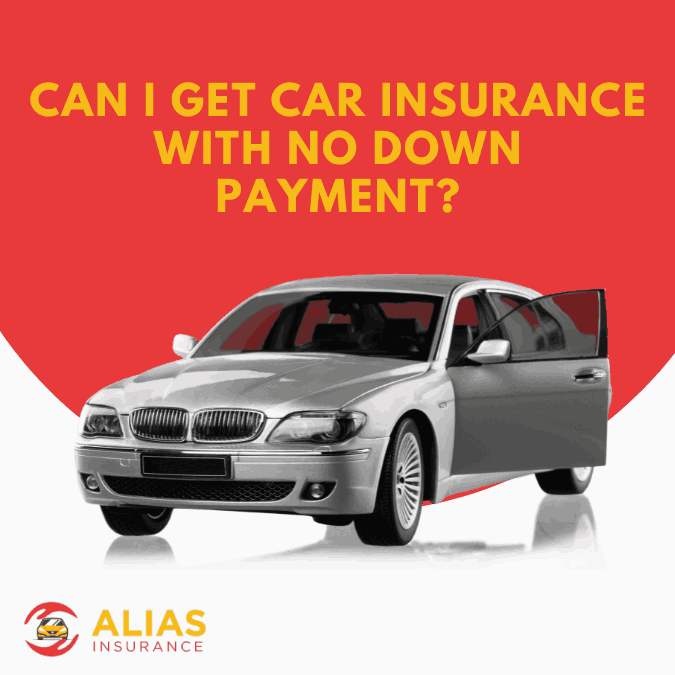
Car insurance is a legal requirement in almost every U.S. state, but for many people, the upfront cost can be a major financial barrier. If you are wondering whether you can get car insurance with no down payment, the short answer is it depends. While most insurers require some form of payment to start a policy, there are ways to reduce or eliminate that initial cost. In this detailed guide, we will explain how no down payment car insurance works, who qualifies, what to watch out for, and how to get the most affordable policy in 2025 without paying hundreds upfront. What Is No Down Payment Car Insurance? No down payment car insurance means getting a policy started without making a large upfront payment. In traditional policies, the first month’s premium or a deposit is required before coverage begins. With no down payment insurance, you might only be required to pay your first month’s premium or even just a small processing fee. However, it is important to understand that there is no such thing as truly free car insurance. You are still required to pay for coverage, but these options allow you to: Spread payments over time Avoid large upfront costs Get insured with limited cash on hand How Does It Work? When you purchase a traditional car insurance policy, most companies ask for: First month’s premium Or a percentage of the full premium as a deposit With a no down payment plan, insurers allow you to start coverage with just the first month’s premium and in rare cases, even defer it for a short period. These plans are usually available through: Monthly installment options State-backed or non-standard providers Insurance comparison platforms like Alias Insurance Who Offers No Down Payment Car Insurance? Not all insurers provide this option, but some companies offer low or no upfront payment plans based on your profile and state regulations. These include: Progressive GEICO State Farm Dairyland The General Acceptance Insurance You can use quote comparison platforms like Alias Insurance to compare these providers and find those offering flexible payments. Who Qualifies for No Down Payment Car Insurance Eligibility varies depending on the provider and your personal details. Generally, you are more likely to qualify if you: Have a clean driving record Have good credit or payment history Are over 25 years old Live in a state that allows installment-based policies Choose basic liability coverage If you are a high-risk driver, have a poor credit score, or require full coverage, you may still qualify but expect to pay slightly more monthly. States Where No Down Payment Insurance Is More Common Not all states allow deferred payments or zero-down car insurance, but it is more accessible in: California Florida Texas Arizona Georgia South Carolina Nevada Always check with your local Department of Insurance or an agent to confirm availability. Pros and Cons of No Down Payment Car Insurance ✅ Advantages No large upfront cost Coverage starts immediately Ideal for low-income drivers or students Easier budgeting with monthly payments ❌ Disadvantages Higher monthly premiums Not available in every state May require automatic payments Limited options for high-risk drivers How Much Does It Cost? Here’s a comparison between traditional and no down payment insurance: Policy Type Upfront Cost Monthly Payment Total Cost (6 Months) Traditional Policy $250 – $500 $90 – $130 $790 – $1,280 No Down Payment Policy $0 – $50 $100 – $150 $600 – $900 You may end up paying slightly more monthly, but save big initially. Tips to Qualify and Save To improve your chances of getting no down payment car insurance, try these tips: Maintain a clean driving record Improve your credit score Choose liability-only coverage Bundle with renters or home insurance Ask about usage-based discounts Use quote comparison sites to shop around Alternatives to No Down Payment Insurance If you cannot find a true no-down-payment policy, consider these options: $20 Down Car Insurance: Many insurers offer policies with only $20 required upfront. Pay-As-You-Go Car Insurance: Pay based on how much you drive, perfect for low-mileage drivers. State-Sponsored Plans: Some states offer low-income auto insurance programs with reduced upfront costs. Is It Legit or a Scam? Legitimate insurers may advertise “no down payment car insurance,” but be cautious of: Unlicensed companies Hidden processing fees Too-good-to-be-true offers Always verify the insurer’s license with your state’s Department of Insurance. FAQs: People Also Ask Can I get no down payment insurance with bad credit? Yes, but you may pay higher monthly rates. Shopping around is key. Is it legal in every state? No. Some states require a full first month’s premium before a policy becomes active Do I still need to provide proof of insurance? Yes. Regardless of how you pay, you must carry proof of insurance at all times. Can I cancel anytime? Yes, but cancellation fees may apply. Read your contract carefully. Does it include full coverage? Yes, if you choose it. No down payment plans can be liability-only or full coverage depending on what you buy. Conclusion: Is No Down Payment Insurance Right for You? If you are short on cash but need to drive legally, no down payment car insurance can be a great solution. It provides the same protection as traditional policies without the financial burden upfront. Just remember: It is not completely free you still pay for coverage Compare quotes to get the best monthly rates Review terms carefully to avoid unexpected fees At Alias Insurance, we help you compare top-rated insurers that offer flexible payment plans, including no or low down payment options. Find the right coverage for your situation today and drive with confidence. External Resource Links National Association of Insurance Commissioners (NAIC) Insurance Information Institute – How Car Insurance Works California Department of Insurance – Low-Cost Auto Insurance AliasInsurance.com – Compare Free Quotes
Can You Trust Peer-to-Peer Car Insurance? How Claims Really Work
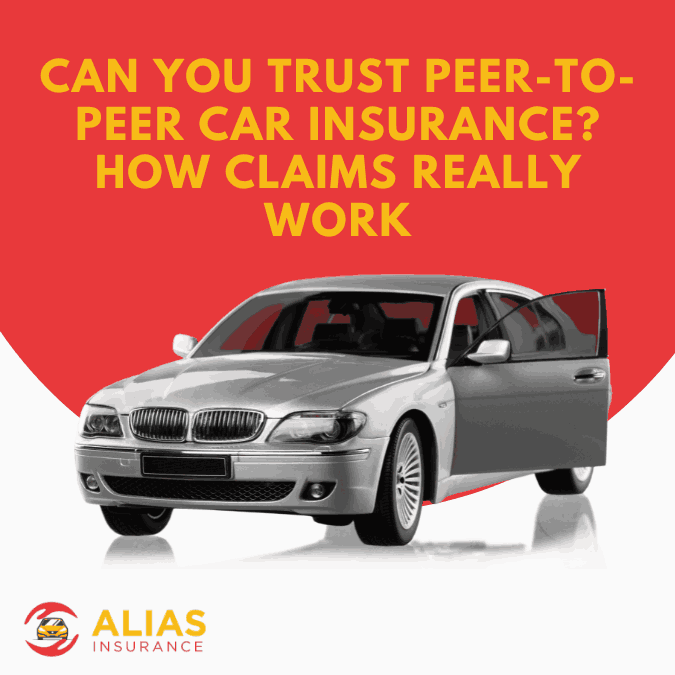
The world of car insurance is changing—and fast. As technology reshapes the way we shop, bank, and commute, it’s also disrupting one of the most traditional financial products: auto insurance. Enter peer-to-peer (P2P) car insurance, a community-based model that promises lower premiums, increased transparency, and refunds for safe drivers. But while it sounds appealing, it isn’t the perfect fit for everyone. So, the big question is: Who should consider peer-to-peer car insurance? In this article, we’ll break down what P2P car insurance is, how it works, and the types of drivers who can benefit the most from it. By the end, you’ll know if this modern approach to coverage is right for you. What Is Peer-to-Peer (P2P) Car Insurance? Peer-to-peer car insurance is an alternative to traditional auto insurance, built around community risk-sharing. Here’s how it works: You join a group (of friends, family, or strangers with similar risk profiles). Everyone in the group pays into a shared claims fund. If someone has a small accident, payouts come from this fund. Larger claims are backed by a traditional insurer or reinsurer. If the group files few or no claims, leftover money may be refunded. Think of it as car insurance powered by a sense of community, enabled by technology. Is It Legit? Yes. While the concept may sound new, most P2P insurance platforms are backed by licensed insurers and comply with state regulations. In most cases, you’re still getting a state-approved policy, but the way it’s priced and managed is different from traditional insurance. Key Features of P2P Car Insurance App-based policies and claims Group-based pricing instead of traditional risk modeling Refund potential if your group stays claim-free Simplified claims for small incidents Reinsurance backup for serious accidents Now that we understand how it works, let’s look at who it’s ideal for. 1. Safe, Low-Risk Drivers If you’re someone who rarely files claims, drives cautiously, and follows the rules of the road, P2P insurance might reward you more than traditional plans. Traditional insurers charge everyone upfront, regardless of whether they file a claim. With P2P insurance, you could get some of that money back at the end of your policy period if your group drives safely. Perfect for: Mature drivers with clean records Drivers with no recent accidents or tickets Drivers frustrated by paying more due to others’ risk profiles 2. Low-Mileage Drivers Many P2P insurers offer discounts or savings for those who don’t drive frequently—a growing segment of the population. If you: Work from home Use public transportation Only drive on weekends or for errands Then your low exposure to risk makes you a great candidate for a P2P plan. 3. Tech-Savvy, App-First Users P2P car insurance is generally managed via smartphone apps, which makes it ideal for digital-first drivers who don’t need in-person agents or old-school paperwork. App features often include: Instant policy access Real-time claims tracking Claims voting (in some platforms) Group transparency and status updates If you’re comfortable managing everything on your phone, P2P is designed with you in mind. 4. Drivers Who Want Transparency Many drivers feel frustrated by the lack of transparency in traditional insurance—especially during claims. P2P platforms often offer: Insight into where your premium dollars go Community-based decisions for small claims Detailed breakdowns of group claims, refunds, and admin fees If you value clarity and openness, P2P models can offer a fresh, customer-focused experience. 5. Budget-Conscious Drivers Looking for Savings Because of lower overhead costs and fraud reduction, P2P insurers often offer lower monthly premiums—and even end-of-term refunds if the group performs well. While not guaranteed, these refunds can add up over time, making this model attractive to cost-conscious drivers. Example savings scenario: Coverage Type Traditional Insurer Peer-to-Peer Platform Monthly Premium $120 $95 Refund (year-end) $0 $100 Annual Cost $1,440 $1,040 6. Drivers in P2P-Supported States Peer-to-peer car insurance is still growing in availability. If you live in a state where P2P providers operate, it may be a good time to explore this model while competition is low and rates are favorable. Common launch markets include: California Texas Illinois New York Florida Use platforms like Alias Insurance to see what’s available in your ZIP code. 7. Community-Minded Drivers One unique aspect of P2P insurance is the sense of shared responsibility. In some platforms, group members can vote on claims, discuss issues, and even create custom communities. This model promotes: Responsible driving behavior Mutual support among group members Reduced fraud due to community monitoring If that sounds better than dealing with a faceless corporation, you may enjoy being part of a P2P group. Who Should Avoid Peer-to-Peer Car Insurance? While P2P insurance is great for many, it’s not for everyone. You might want to stick with traditional insurance if you: ❌ Drive a lot or have a long commute ❌ Have a history of accidents or violations ❌ Prefer working with local agents ❌ Need commercial or high-risk coverage ❌ Live in a state where P2P isn’t available Also, if you expect to file multiple claims or need very specific policy add-ons, traditional insurers may offer more robust options. FAQs: People Also Ask Is peer-to-peer car insurance cheaper? Often, yes—especially for safe and low-mileage drivers. Plus, you may receive refunds at the end of your policy term if your group avoids claims. Is peer-to-peer car insurance legit in the U.S.? Yes. P2P insurers are typically partnered with licensed insurers or reinsurers and operate legally under state insurance regulations. What happens if my group has lots of claims? Your group’s fund may be depleted, and your premium could rise next term. Large claims are usually backed by the partner insurer, so coverage remains intact. Do I still get standard coverages (like liability, comp, and collision)? Yes. Most P2P platforms offer the same coverages required by law and comparable to traditional policies. Can I switch back to traditional insurance later? Absolutely. Just like with any insurance provider, you can cancel and switch at any time without penalty—as long as you maintain continuous coverage.
Who Should Consider Peer-to-Peer Car Insurance?
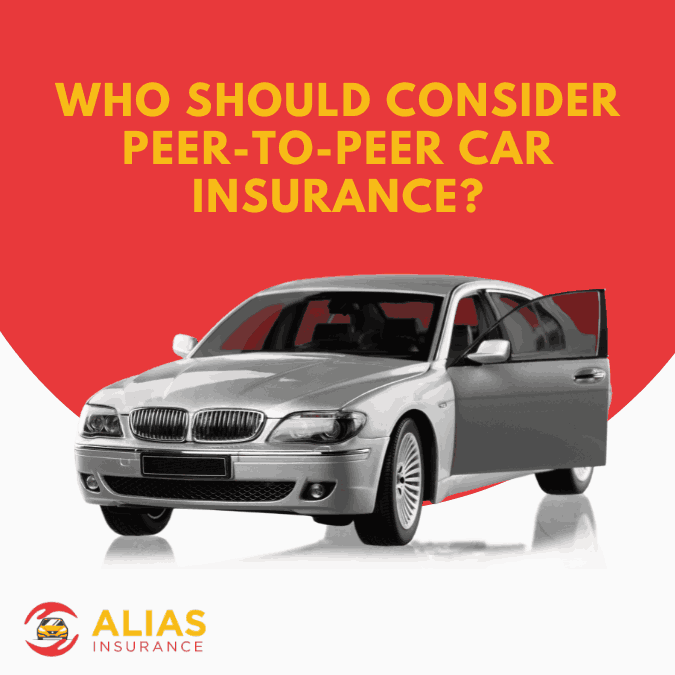
The world of car insurance is changing and fast. As technology reshapes the way we shop, bank, and commute, it’s also disrupting one of the most traditional financial products: auto insurance. Enter peer-to-peer (P2P) car insurance, a community-based model that promises lower premiums, increased transparency, and refunds for safe drivers. But while it sounds appealing, it isn’t the perfect fit for everyone. So, the big question is: Who should consider peer-to-peer car insurance? In this article, we’ll break down what P2P car insurance is, how it works, and the types of drivers who can benefit the most from it. By the end, you’ll know if this modern approach to coverage is right for you. What Is Peer-to-Peer (P2P) Car Insurance? Peer-to-peer car insurance is an alternative to traditional auto insurance, built around community risk-sharing. Here’s how it works: You join a group (of friends, family, or strangers with similar risk profiles). Everyone in the group pays into a shared claims fund. If someone has a small accident, payouts come from this fund. Larger claims are backed by a traditional insurer or reinsurer. If the group files few or no claims, leftover money may be refunded. Think of it as car insurance powered by a sense of community, enabled by technology. Is It Legit? Yes. While the concept may sound new, most P2P insurance platforms are backed by licensed insurers and comply with state regulations. In most cases, you’re still getting a state-approved policy, but the way it’s priced and managed is different from traditional insurance. Key Features of P2P Car Insurance App-based policies and claims Group-based pricing instead of traditional risk modeling Refund potential if your group stays claim-free Simplified claims for small incidents Reinsurance backup for serious accidents Now that we understand how it works, let’s look at who it’s ideal for. 1. Safe, Low-Risk Drivers If you’re someone who rarely files claims, drives cautiously, and follows the rules of the road, P2P insurance might reward you more than traditional plans. Traditional insurers charge everyone upfront, regardless of whether they file a claim. With P2P insurance, you could get some of that money back at the end of your policy period if your group drives safely. Perfect for: Mature drivers with clean records Drivers with no recent accidents or tickets Drivers frustrated by paying more due to others’ risk profiles 2. Low-Mileage Drivers Many P2P insurers offer discounts or savings for those who don’t drive frequently a growing segment of the population. If you: Work from home Use public transportation Only drive on weekends or for errands Then your low exposure to risk makes you a great candidate for a P2P plan. 3. Tech-Savvy, App-First Users P2P car insurance is generally managed via smartphone apps, which makes it ideal for digital-first drivers who don’t need in-person agents or old-school paperwork. App features often include: Instant policy access Real-time claims tracking Claims voting (in some platforms) Group transparency and status updates If you’re comfortable managing everything on your phone, P2P is designed with you in mind. 4. Drivers Who Want Transparency Many drivers feel frustrated by the lack of transparency in traditional insurance especially during claims. P2P platforms often offer: Insight into where your premium dollars go Community-based decisions for small claims Detailed breakdowns of group claims, refunds, and admin fees If you value clarity and openness, P2P models can offer a fresh, customer-focused experience. 5. Budget-Conscious Drivers Looking for Savings Because of lower overhead costs and fraud reduction, P2P insurers often offer lower monthly premiums and even end-of-term refunds if the group performs well. While not guaranteed, these refunds can add up over time, making this model attractive to cost-conscious drivers. Example savings scenario: Coverage Type Traditional Insurer Peer-to-Peer Platform Monthly Premium $120 $95 Refund (year-end) $0 $100 Annual Cost $1,440 $1,040 6. Drivers in P2P-Supported States Peer-to-peer car insurance is still growing in availability. If you live in a state where P2P providers operate, it may be a good time to explore this model while competition is low and rates are favorable. Common launch markets include: California Texas Illinois New York Florida Use platforms like Alias Insurance to see what’s available in your ZIP code. 7. Community-Minded Drivers One unique aspect of P2P insurance is the sense of shared responsibility. In some platforms, group members can vote on claims, discuss issues, and even create custom communities. This model promotes: Responsible driving behavior Mutual support among group members Reduced fraud due to community monitoring If that sounds better than dealing with a faceless corporation, you may enjoy being part of a P2P group. Who Should Avoid Peer-to-Peer Car Insurance? While P2P insurance is great for many, it’s not for everyone. You might want to stick with traditional insurance if you: ❌ Drive a lot or have a long commute ❌ Have a history of accidents or violations ❌ Prefer working with local agents ❌ Need commercial or high-risk coverage ❌ Live in a state where P2P isn’t available Also, if you expect to file multiple claims or need very specific policy add-ons, traditional insurers may offer more robust options. FAQs: People Also Ask Is peer-to-peer car insurance cheaper? Often, yes, especially for safe and low-mileage drivers. Plus, you may receive refunds at the end of your policy term if your group avoids claims. Is peer-to-peer car insurance legit in the U.S.? Yes. P2P insurers are typically partnered with licensed insurers or reinsurers and operate legally under state insurance regulations. What happens if my group has lots of claims? Your group’s fund may be depleted, and your premium could rise next term. Large claims are usually backed by the partner insurer, so coverage remains intact. Do I still get standard coverages (like liability, comp, and collision)? Yes. Most P2P platforms offer the same coverages required by law and comparable to traditional policies. Can I switch back to traditional insurance later? Absolutely. Just like with any insurance provider, you can cancel and switch at any time without penalty—as long
Peer-to-Peer Car Insurance vs Traditional Insurance: What’s the Difference?
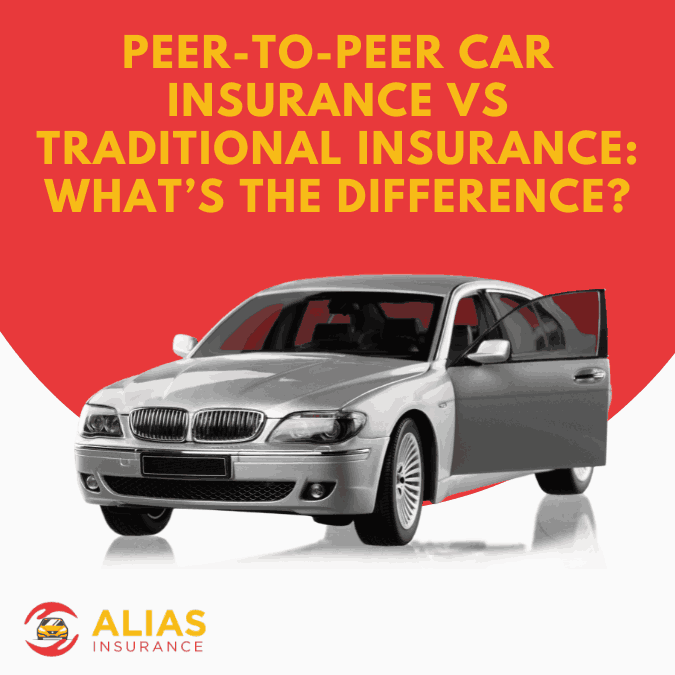
If you’ve been exploring ways to save money on car insurance in 2025, chances are you’ve come across the term peer-to-peer (P2P) car insurance. Promising more transparency, lower premiums, and community-driven claims processes, this model seems to offer a fresh take on how insurance should work. But how does it actually stack up against traditional insurance? Is it better? Cheaper? Riskier? In this detailed comparison, we’ll break down everything you need to know about peer-to-peer car insurance vs traditional insurance so you can make the best decision for your wallet and peace of mind. What Is Peer-to-Peer Car Insurance? Peer-to-peer car insurance (P2P insurance) is a newer insurance model where drivers are grouped together into small communities that pool their premiums. When someone in the group files a claim, it’s paid from the shared pool. Any leftover funds at the end of the term may be refunded or rolled over to the next period. Key components: Risk is shared among group members. Smaller claims are paid from the group pool. Larger claims are backed by a traditional insurance provider (reinsurer). This approach aims to minimize fraud, reduce overhead costs, and promote responsible driving through community-based accountability. What Is Traditional Car Insurance? Traditional car insurance is the standard model we’re all familiar with. You pay a premium to an insurance company, and in return, they cover your losses if you’re involved in an accident or other covered event. Features of traditional insurance: Premiums are based on personal risk factors (age, location, driving record, etc.). Claims are handled directly by the insurer. All funds go to the insurer, regardless of claim activity. Most major providers in the U.S. (like State Farm, GEICO, Progressive) operate under this model. Key Differences Between P2P and Traditional Insuranc Let’s break it down side-by-side. Feature Peer-to-Peer Insurance Traditional Insurance Structure Group-based risk pooling Insurer-backed individual policies Claims Handling Shared pool (small) + insurer (large) Fully managed by insurer Refund Potential Yes, if group claims are low Rare or none Pricing Community-based, potentially cheaper Risk-based, sometimes higher Transparency High (app-based, voting options) Lower (standard claims systems) Availability Limited (pilot programs, select states) Nationwide Regulation Must be state-licensed (indirect) Fully regulated by each state Pros of Peer-to-Peer Car Insurance ✅ 1. Potential for Lower Premiums By minimizing administrative overhead and claims fraud, P2P insurers often charge less than traditional providers especially for low-risk drivers. ✅ 2. Refunds for Safe Driving If your group has few or no claims, you may receive a refund or credit at the end of your policy period. ✅ 3. More Transparency Some P2P platforms allow you to track group claims, vote on payouts, and view how funds are allocated. ✅ 4. Community-Driven Accountability Because you’re sharing risk with others, everyone has an incentive to drive more responsibly. Cons of Peer-to-Peer Car Insurance ❌ 1. Limited Availability Many P2P insurers are startups or app-based platforms and may only operate in a few states. ❌ 2. Smaller Network Lack of established infrastructure can affect customer service, claims processing, or roadside support. ❌ 3. Refunds Not Guaranteed If your group files several claims, your premium may stay the same—or even rise—and there may be no refund. ❌ 4. Unclear Long-Term Viability As a newer model, some P2P providers may pivot, fold, or get acquired, raising questions about continuity. Pros of Traditional Car Insurance ✅ 1. Nationwide Coverage Traditional insurers offer statewide and nationwide availability with comprehensive support. ✅ 2. Trusted Names Companies like GEICO, Allstate, and State Farm have decades of experience and strong financial backing. ✅ 3. Streamlined Claims Process Larger insurers have dedicated claims teams, 24/7 roadside assistance, and robust apps or call centers. ✅ 4. Variety of Coverage Options From rideshare add-ons to SR-22 filings, traditional companies offer customizable plans for nearly every driver. Cons of Traditional Car Insurance ❌ 1. Less Personalization Policies are based on generalized data models and risk tiers. It’s not always flexible or fair for every driver. ❌ 2. No Refunds for Low Claims Even if you don’t file a single claim, you won’t see a dime back at the end of the year. ❌ 3. Higher Overhead Costs Big insurers have agents, offices, and corporate overhead which can lead to higher premiums. Cost Comparison Example Let’s look at an estimated annual cost comparison between P2P and traditional insurance: Driver Profile Traditional Insurance Peer-to-Peer Insurance Age 30, clean record $1,300/year $1,050/year (with $100 refund) Age 22, new driver $2,000/year $1,800/year (no refund) Age 45, low-mileage driver $1,100/year $950/year (plus refund potential) Note: Actual rates depend on state, provider, vehicle, and group performance. What Happens When You File a Claim? With Traditional Insurance: File through your insurer’s website or app. Claims are handled internally with adjusters. Deductible applies, and payout is based on coverage limits. With P2P Insurance: Small claims may be voted on or reviewed by the group. Larger claims are escalated to the partnering reinsurer. Refund eligibility may decrease if the group fund is used. Who Should Choose Peer-to-Peer Car Insurance? P2P insurance might be a good fit for:✅ Drivers with low annual mileage✅ Tech-savvy individuals comfortable managing policies via app✅ People in states where P2P options are available✅ Safe drivers looking for potential refunds✅ Younger drivers who want a more flexible pricing model Who Should Stick with Traditional Insurance? Traditional insurance is probably better for: ✔️ High-risk drivers (tickets, accidents, SR-22) ✔️ Those who want in-person service or agents ✔️ People with multiple vehicles or complex coverage needs ✔️ Business or rideshare drivers ✔️ Anyone living in a state without P2P providers Real-World Example Name: Rachel, age 33 Location: Austin, TX Car: 2021 Toyota Camry Driving Record: Clean Old Policy: $125/month with a national insurer New P2P Policy: $98/month via app End-of-Term Refund: $75 Rachel saved nearly $400 per year, and her group had zero claims earning her a refund at renewal. Her feedback? “It felt good knowing I could get some money back for driving safely.” FAQs: People Also Ask Is peer-to-peer car insurance
